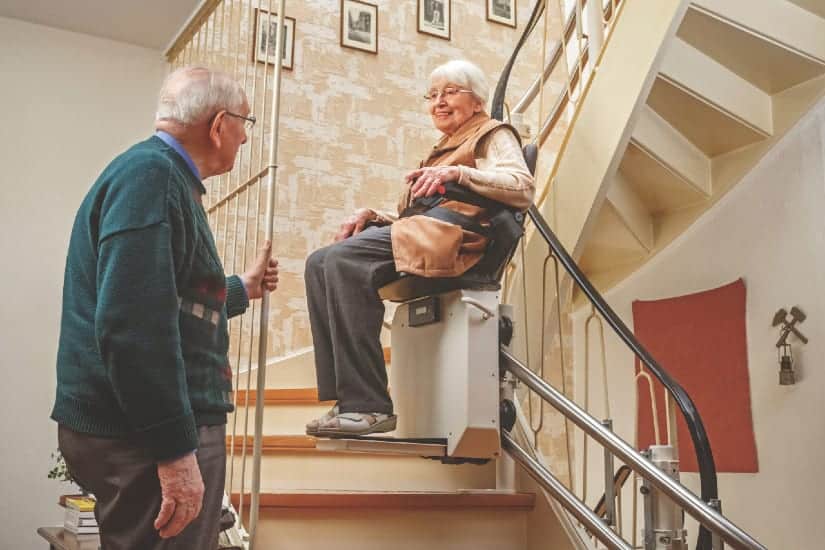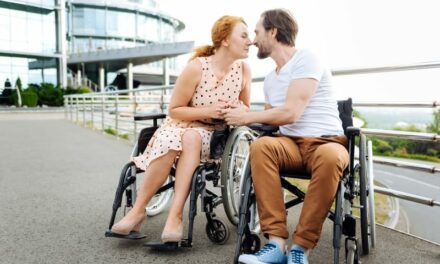PHOTO CAPTION: Accessibility can be a barrier even at home. Installing stair lifts is one way to promote independent ambulation inside the home.
Modifications that promote activity and movement can help reduce the risk of injury and falls at home
by Courtney L. Gilbert, PT, DPT
Enjoying more time at home is relaxing, calming, and even fun. As comforting as home can be, more time spent there can sometimes lead to a more sedentary lifestyle. As humans, we are spending increasingly more time in environments that promote prolonged sitting and inactivity—increased screen time, working from home, navigating a pandemic, etc. Decreased physical activity and exercise increases risk of injury, especially in the elderly population. Inactivity can lead to weakening muscles, weight gain, slowed reaction times, and decreased balance, along with many other physical changes.
Prioritizing health and fitness over the lifetime can tremendously decrease the risk of injuries and falls as we age. Elders are at a higher risk for falls due to physiological changes secondary to aging, which can include problems with hearing, eyesight, sensory deficits affecting balance, decreasing muscle mass, and medical conditions. Some external factors that have the potential to contribute to the risk of falls include improper shoe wear, slippery surfaces, uneven floors, and dimly lit areas. Fortunately, preventative measures such as making home modifications and performing home-based exercise are ways to decrease the risk of falls and injuries and maintain fitness over the lifespan.
Assessing the Home
The first step in beginning an active lifestyle at home is to assess the space. Structural design and accessibility can help adults and older adults maintain independence and age in place. The Guidelines of the American Geriatrics Society recommend modification of environmental hazards, training paths, hip protectors, and appropriate use of support tools (like sticks and walkers), which can be effective elements of a multifactorial intervention program.1
One option for aging adults to consider is a home modification intervention. Occupational and physical therapists often work together to ensure a home is safe to support an individual’s life. They assess an individual’s functional ability and activity performance to safely determine what home modifications would best set an individual up for success. A professional home modification intervention is a suitable option for individuals who have experienced a dramatic change in mobility or are experiencing changes in age-related disabilities.
Aging Safely & Home Modifications
In community-dwelling-adults over age 65, the annual prevalence of falls is 1 in 3, with about 50% of those falls resulting in hospitalizations for trauma.1 Home modifications are a great way to provide environmental support to compensate for functional mobility changes in community-dwelling adults to prevent falls, injuries, and trips to the hospital.
Sensory systems including visual input, vestibular input, and proprioception decline as we age. Our ability to integrate sensory systems also slows, in addition to a decrease in skeletal muscle mass and strength.3 There are simple home modifications that can help adults adapt to age-related changes and maintain functional mobility and independence. For example, enhanced lighting can help individuals see level changes and improve vision. A contemporary study showed that the relative risk of losing balance was increased from 5.7 to 7.4 times when visual input was diminished in addition to proprioception.3 Proper lighting can make a huge difference in decreasing fall risk.
Some notable home modifications for the bathroom include grab bars on bathroom walls, showers, and near the toilet; a raised toilet seat; non-slip shower mat; and shower chair or converting to a walk-in shower. Compensating for functional loss by providing environmental support appears to be a promising solution.2
To help adults safely age in place, there are some fall prevention modifications to consider. Removing throw rugs, wearing proper non-slip house shoes or socks, and wearing an alarm in order to call for help in the event of a fall are some ways to make the home safer for people at risk of falls. Home modifications and assistive and communication technologies have been found to prevent functional decline and disability, promote independent activity and safety, increase task self-efficacy, and enhance health outcomes.4
Accessibility can also be a barrier even at home. One approach to lowering such barriers includes the installation of ramps at entrances. Options include aluminum ramps built as modular systems that can be moved or configured as circumstances require. Aluminum curb ramps and folding ramps can also reduce accessibility barriers. Stair lifts are another technology that can increase accessibility by enabling individuals with limited mobility to move between the levels of a home. Providing individuals with the proper walking device can also help promote independent ambulation outside and inside the home.
Another modification for entrances is to consider installing proper or automatic door opening systems. Some of the useful features these technologies provide include remote control door openers, wireless push pads, and controllers that can be mounted to a wheelchair. Some doors can inflict an unpredictable perturbation depending on the spring system. Reactive balance declines along with a greater peak displacement of center of pressure and center of mass after an unpredictable perturbation.5 Overall, there are many modifications that can be made to adjust the home as we age. It is important to consider safety and independence when making any home modifications.
Fitness Over the Lifespan and Home Equipment
Physical activity reduces many major mortality risks. All-cause mortality is decreased by 30%-35% in physically active adults as compared to non-active.6 There are health risks associated with sedentary behavior, and more attention needs to be given to reducing prolonged sitting and to increase light-intensity activities (eg, standing and incidental walking), in addition to engaging in regular moderate-to-vigorous activity.7 For each Nm/kg increase in lower extremity muscle strength, the adjusted odds of losing balance decreased by 20%.3 Thus, integrating exercise as a part of a daily routine can have significant effects on muscle strength and decrease the likelihood of incurring a fall.
There is a difference between sedentary (too much sitting or lack of movement), light/physical activity (household ADLs, walking, etc), and exercise/moderate-vigorous activities.7 Public health recommendations include engaging in at least 150 minutes per week of moderate to vigorous activity to help prevent and manage multiple chronic conditions, notably cardiovascular disease and type 2 diabetes.
Science, material engineering, and technology have made exercising without traveling to a gym very doable and easy at home. Some exercise classes may not require equipment while others do. One means of exercise is equipment-free, such as streaming a cardio or HIIT workout on YouTube, or watching exercise DVDs, etc. Examples of home equipment worth investing in include items for strength, cardiovascular, and balance training. Strength equipment such as short resistance loops, resistance bands, Pilates rings, and light to heavy dumbbell sets are good pieces of equipment to help strengthen and build muscle. Cardiovascular equipment for home can include a jump rope, treadmill, stationary bike, or elliptical to maintain heart health and improve endurance. Balance equipment can include anything from an unstable surface like a foam pad or disc, pillow, or unsteady board to change a person’s base of support in different stances.
After the needed equipment is purchased, developing a regimen and using it is the next step to establishing a routine to support fitness as we age. Equipment abandonment at home is a concern. Some ways to avoid non-use is to place the equipment in a room that is visited every day and make it visible. It is more likely to get used if it is seen daily. Avoid placing the equipment in rooms with poor lighting, especially in the winter months. Maintaining fitness over the life span is important to prevent various health conditions, maintain independence, improve overall well-being, and prolong life expectancy. The relative risk of death is approximately 20% to 35% lower in physically active and fit persons compared to that of inactive and unfit persons.7
Individualization is Key
Establishing a regimen that supports a healthy lifestyle at home requires time, equipment, and education. Exercise and home modification are both ways to decrease an individual’s risk of falls and maintain fitness over the lifespan. However, individualization is key. Selecting the proper home modifications, home exercise equipment, and exercise type is best executed with the help of professionals. Occupational and physical therapists and personal trainers are great resources to use to individualize a home plan. Physiological changes occur as we age, and modifying the home to promote safety, independence, and exercise are a few ways to mitigate the aging process and maintain fitness over the lifespan. RM
Courtney L. Gilbert, PT, DPT, is a physical therapist at ATI Physical Therapy in Hometown, Ill. Courtney earned her doctorate of physical therapy from Northwestern University and currently works in the outpatient setting. Her interests include sports physical therapy and fitness over the life span, and she has unique experiences and knowledge working with patients with gait impairments. For more information, contact [email protected].
References
- Ungar A, Rafanelli M, Iacomelli I, et al. Fall prevention in the elderly. Clin Cases Miner Bone Metab. 2013;10(2):91-95.4
- Stark S, Landsbaum A, Palmer JL, Somerville EK, Morris JC. Client-centred home modifications improve daily activity performance of older adults. Can J Occup Ther. 2009;76 Spec No(Spec No):235-245. doi:10.1177/000841740907600s09
- Osoba MY, Rao AK, Agrawal SK, Lalwani AK. Balance and gait in the elderly: A contemporary review. Laryngoscope Investig Otolaryngol. 2019;4(1):143-153. doi:10.1002/lio2.252
- Sanford J. The Physical Environment and Home Health Care. The Role of Human Factors in Home Health Care: Workshop Summary. National Academies Press (US); 2010. 10. Available from: https://www.ncbi.nlm.nih.gov/books/NBK210046/
- Kanekar N, Aruin AS. Aging and balance control in response to external perturbations: role of anticipatory and compensatory postural mechanisms. Age (Dordr). 2014;36(3):9621. doi:10.1007/s11357-014-9621-8
- Reimers CD, Knapp G, Reimers AK. Does physical activity increase life expectancy? A review of the literature. J Aging Res. 2012;2012:243958. doi:10.1155/2012/243958
- Owen N, Sparling PB, Healy GN, Dunstan DW, Matthews CE. Sedentary behavior: emerging evidence for a new health risk. Mayo Clin Proc. 2010;85(12):1138-1141. doi:10.4065/mcp.2010.0444





